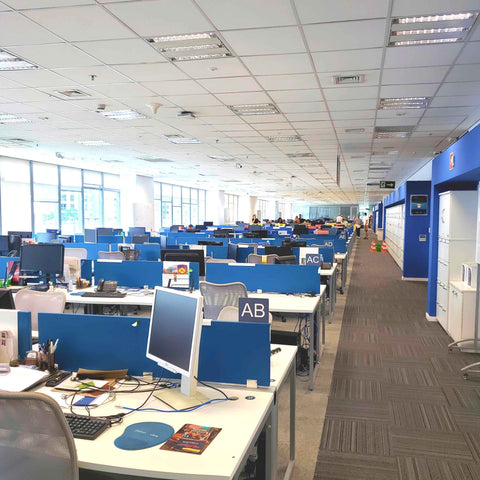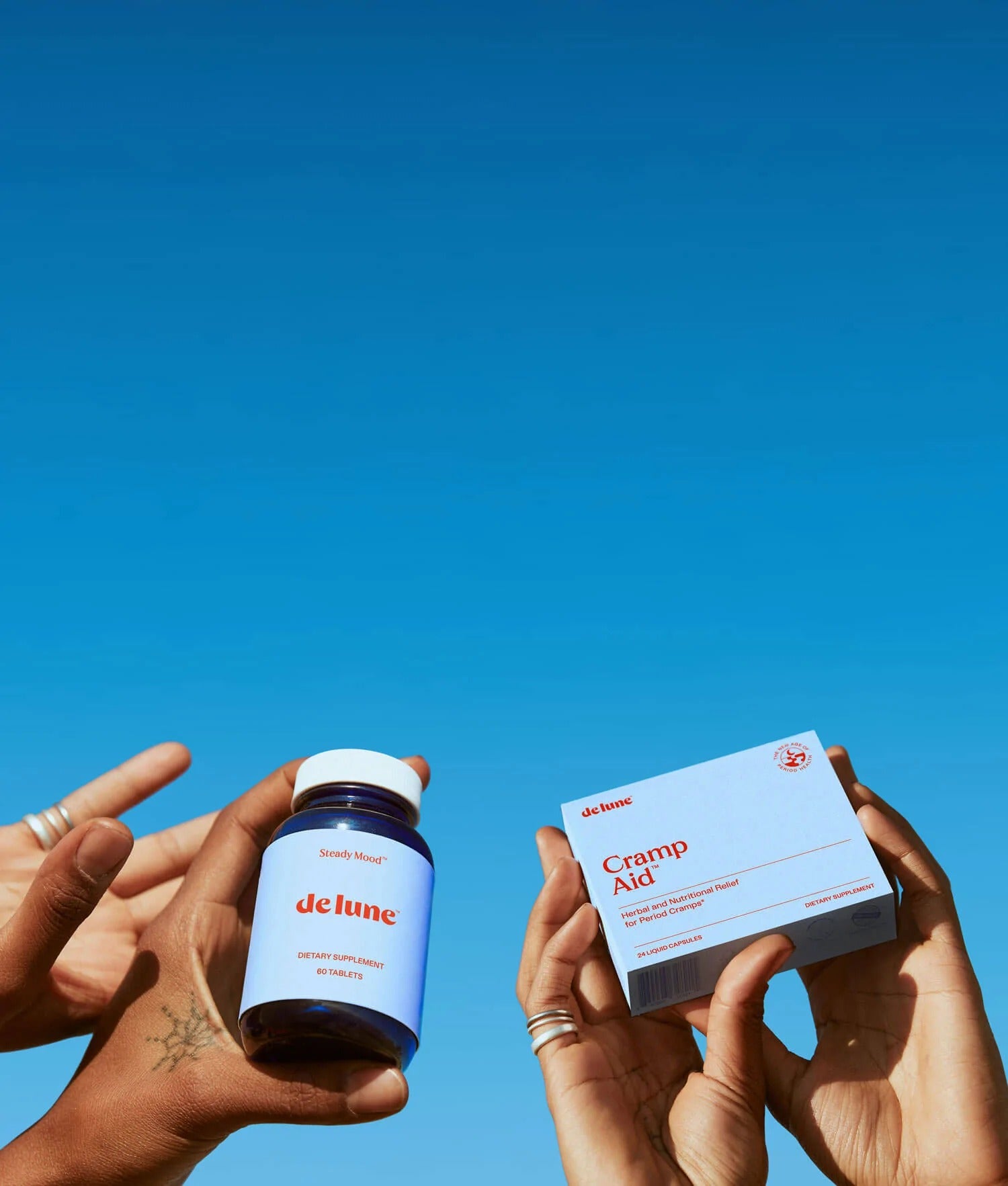Despite being the status-quo options for cramp relief, over-the-counter drugs and medication aren’t the only effective ways to help with period cramps.
Research shows certain natural remedies can help with period cramps significantly—sometimes dramatically. [1] Some natural period cramp remedies have even gone toe-to-toe with OTC painkillers in clinical trials, with near-identical results. [2]
This article explains how to help with cramps when you’re on your period, while avoiding drugs like pain-relieving drugs, hormonal birth control, or prescription muscle relaxers. It covers:
- Step one in choosing a period cramp remedy: knowing your cramp type
- Nine natural period cramp remedies that can deliver real relief, according to science
- How they work to address root causes of menstrual pain
Quick tip:
Research shows high-potency nutrient supplements and herbal extracts are among the most effective ways to help with period cramps naturally. We included the nutrients and herbs with the best evidence in Cramp Aid—a fast-acting, use-as-needed supplement for cramp relief. It’s our top recommendation for how to help with period cramps quickly.
Cramp relief basics: identifying your period cramp type
How you help with period cramps usually varies depending on which type of menstrual pain you have: primary or secondary dysmenorrhea.
Primary dysmenorrhea
It’s estimated that nearly 90% of period cramp cases are primary dysmenorrhea—or menstrual pain without an underlying condition. [3] These cramps are caused by inflammatory processes in the uterus that shed the uterine lining at the end of the menstrual cycle.
Some people get worse primary dysmenorrhea pain than others for a number of reasons. If you experience severe cramps that interfere with your day-to-day life, talk to a healthcare provider.
Secondary dysmenorrhea
Secondary dysmenorrhea—or menstrual pain with an underlying condition—is caused by the same inflammatory processes as primary dysmenorrhea, but they play out in the presence of a gynecological disorder like endometriosis, adenomyosis, or uterine fibroids.
Cramping from secondary dysmenorrhea is generally more severe. It's best treated by a healthcare provider, as medication or surgery are sometimes needed. Because treatment often targets the underlying condition, the natural cramp remedies in this article are most effective when used for primary dysmenorrhea. However you and your doctor may decide to include them among the therapies in your secondary dysmenorrhea treatment plan.
How to help with period cramps
The most effective ways to help with period cramps generally involve addressing the underlying factors in the uterus that lead to menstrual cramping in the first place. Experts say period cramps are caused by a combination of: [4]
- Inflammation
- Muscle contraction
- Lack of oxygen
Research suggests the natural medicines below can intervene at one or more steps in this process to help with cramping on your period.
Anti-inflammatory options to help with period cramps
Before each period (if you’re not pregnant), inflammation-causing compounds called prostaglandins form to help agitate the muscles in the uterus and dislodge the uterine lining. While some prostaglandins are necessary to set periods in motion, bad cramps happen when the body makes more prostaglandins than it needs due to a variety of factors.
Research shows supplements like ginger and zinc can help with period cramps by targeting inflammatory prostaglandins in the uterus.
GINGER
Ginger is like nature’s painkiller, home to dozens of different types of antioxidants with anti-inflammatory powers. Scientists suggest ginger helps block the production of uterine prostaglandins, preventing cramp-causing inflammation before it starts—precisely how medicines like ibuprofen, Advil, and other NSAIDs also work to relieve pain. [5]
Two clinical trials compared ginger supplements to NSAIDs for period cramp relief, and both reported ginger was just as effective. [2, 6] Other researchers reviewed eight clinical trials on ginger, and concluded it’s safer than NSAIDs when used as a pain treatment. [7]
ZINC
Scientists suspect zinc uses different modes of action to help with period cramps, reducing uterine prostaglandins among them. [8] Zinc’s strong antioxidant activity also gives it anti-inflammatory abilities—which it appears to use on uterine blood vessels during menstruation to improve oxygen flow to the uterus and prevent cramping. [9]
In one clinical trial, participants who took zinc supplements in the days leading up menstruation needed less medicine during their period, and had reduced menstrual pain, bleeding, and PMS symptoms. [10]
Remedies to help period cramps by soothing uterine muscles
When too many prostaglandins are made before your period, uterine muscles contract too tightly and cause cramping. Research shows women with dysmenorrhea have tighter uterine muscles, more frequent contractions, and more uterine pressure compared to women without cramps. [11]
Natural approaches like fenugreek, dong quai, magnesium, and heat may relax uterine muscles during menstruation, helping to shed the uterine lining without excessive muscle contraction.
FENUGREEK
Fenugreek is an antispasmodic herb, meaning it calms muscles. Not only may it ease uterine muscle spasms to help with period cramps, it may also soothe gastrointestinal muscles to prevent period poops. [12]
A natural anti-inflammatory, fenugreek works overtime to relieve inflammation with soothing antioxidants. In one clinical trial, fenugreek actually outperformed an over-the-counter painkiller for period cramp relief. [13]
DONG QUAI
A cornerstone herb for women’s health in Traditional Chinese Medicine (TCM), dong quai is used for all sorts of reproductive woes, from period cramps and menstrual irregularities, to hormonal imbalances and menopausal symptoms. [14]
Dong quai appears to regulate the muscles of the uterus. Rather than stopping contractions completely, it alternates between stimulating and relaxing uterine muscles in a controlled rhythm. [15] By balancing lining-shedding efficiency with soothing breaks to keep contractions in check, cramps may become less noticeable, and spotty or heavy flows more regular.
MAGNESIUM
Magnesium plays a crucial role in muscle contraction. Because muscles can’t relax without enough magnesium, some researchers think period cramps are a symptom of magnesium deficiency. [16]
A true multitasker, magnesium may also reduce uterine prostaglandins, soothe period back pain, and ease menstrual migraines. [17, 18] It can be tricky to get an accurate read on the body’s magnesium stores from standard tests, so levels may be lower than you realize.
HEAT
A heating pad to the abdomen is a tried and true cramp remedy—and for the most part, the science backs it up. Heat is thought to help with period pain by relaxing uterine muscles, and encouraging the flow of blood and oxygen to the area.
Heat therapy was shown to be just as helpful as pain-relieving medicine like ibuprofen or Tylenol for period cramps in three clinical studies. [19] But another study comparing heat to ibuprofen found that using a heat patch and ibuprofen together was about as effective as using an unheated patch and ibuprofen, suggesting some placebo effect. [20]
Remedies that boost oxygen flow to help with period cramps
When uterine muscles contract too tightly from prostaglandin overload, they can constrict blood vessels that supply oxygen and nutrients. Pain from period cramps is the feeling of your uterine muscles being starved of oxygen. [21]
Research suggests that saffron, exercise, and TENS machines may help boost blood flow to the uterus, ensuring it gets enough oxygen during your period.
SAFFRON
Research shows saffron can have impressive benefits for periods, from soothing cramps and menstrual moods, to curbing PMS cravings. Scientists propose it helps with menstrual cramps by improving blood circulation. When included in a blend with two other herbs, its cramp relief benefits were similar to ibuprofen. [22]
EXERCISE
Physical activity is a reliable way to improve oxygen flow throughout the body, including your uterus. Research shows aerobic exercise significantly improves dysmenorrhea, though results may only apply to regular exercise. Participants in one study committed to 30 minute workouts 3X/week, all month long for two months. [23]
TENS
Transcutaneous Electrical Nerve Stimulation, or TENS machines, are wearable devices that attach to your abdomen with adhesive pads, and send low-voltage electrical currents into uterine muscles and nerves. One way these devices are thought to help with period cramps is by dilating blood vessels in the area, thereby boosting blood and oxygen flow.
Research suggests TENS machines are a safe and effective way to help with period cramps [24], though may not be a logistical fit for everyone. They can be bulky under clothing, must be kept away from water, and are considerably more expensive than other options.
How to help with period cramps quickly
Because most options for cramp relief address only one or two parts of the period pain cascade, the fastest way to help with period cramps naturally may be to use multiple remedies at once, each targeting a different root cause.
You can find potent doses of ginger, fenugreek, dong quai, and zinc in Cramp Aid, all blended into rapid-release liquid capsules for fast absorption. In a survey of over 140 random Cramp Aid users, 83% got relief within one hour of taking one dose.
Find other natural period remedies like magnesium, saffron, and zinc in Steady Mood—a daily supplement for multi-symptom PMS relief. Learn how Cramp Aid and Steady Mood work together here.
This information is for educational purposes only. It is not a substitute for professional medical advice, and is not intended to diagnose, treat, cure, or prevent any condition.
References
1. Gokhale, L. B. (1996). Curative treatment of primary (spasmodic) dysmenorrhoea. Indian Journal of Medical Research, 103, 227-231.
2. Ozgoli, G. et al. (2009). Comparison of effects of ginger, mefenamic acid, and ibuprofen on pain in women with primary dysmenorrhea. The journal of alternative and complementary medicine, 15(2), 129-132.
3. Polat, A. et al. (2009). Prevalence of primary dysmenorrhea in young adult female university students. Archives of gynecology and obstetrics, 279(4), 527-532.
4. Åkerlund, M. (1979). Pathophysiology of dysmenorrhea. Acta Obstetricia et Gynecologica Scandinavica, 58(sup87), 27-32.
5. Ali, B. H. et al. (2008). Some phytochemical, pharmacological and toxicological properties of ginger (Zingiber officinale Roscoe): a review of recent research. Food and chemical Toxicology, 46(2), 409-420.
6. Shirvani, M. A. et al. (2015). The effect of mefenamic acid and ginger on pain relief in primary dysmenorrhea: a randomized clinical trial. Archives of gynecology and obstetrics, 291(6), 1277-1281.
7. Lakhan, S. E. et al. (2015). Zingiberaceae extracts for pain: a systematic review and meta-analysis. Nutrition journal, 14(1), 1-10.
8. Kelly, R. W., & Abel, M. H. (1983). Copper and zinc inhibit the metabolism of prostaglandin by the human uterus. Biology of Reproduction, 28(4), 883-889.
9. Widatiningsih, S., & Handayani, E. (2017). Influence of Zinc Tablets Administration to Primary Dysmenorrhea Pain Level. ARC Journal of Nursing and Healthcare, 3(3), 35-38.
10. Sangestani, G. et al. (2015). The positive effects of zinc supplements on the improvement of primary dysmenorrhea and premenstrual symptoms: a double-blind, randomized, controlled trial. Journal of Midwifery and Reproductive Health, 3(3), 378-384.
11. Dawood, M. Y. (2006). Primary dysmenorrhea: advances in pathogenesis and management. Obstetrics & Gynecology, 108(2), 428-441.
12. Natarajan, B., & Dhananjayan, R. (2007). Pharmacological effects of Trigonella foenum graecum Linn. Seeds on various isolated perfused smooth muscle preparations. Pharmacognosy Magazine, 3(10), 77.
13. Inanmdar, W. et al. (2016). Clinical efficacy of Trigonella foenum graecum (Fenugreek) and dry cupping therapy on intensity of pain in patients with primary dysmenorrhea. Chinese journal of integrative medicine, 1-8.
14. Hook, I. L. (2014). Danggui to Angelica sinensis root: are potential benefits to European women lost in translation? A review. Journal of ethnopharmacology, 152(1), 1-13.
15. Yu, Y. et al. (2009). Inhibitory Effects of Two Ferulates from on Platelet Aggregation and Oxytocin-induced Uterine Contraction. The Open Bioactive Compounds Journal, 2(1).
16. Ebrahimi, E. et al (2012). Effects of magnesium and vitamin b6 on the severity of premenstrual syndrome symptoms. Journal of caring sciences, 1(4), 183.
17. Fontana-Klaiber, H., & Hogg, B. (1990). Therapeutic effects of magnesium in dysmenorrhea. Schweizerische Rundschau fur Medizin Praxis= Revue Suisse de Medecine Praxis, 79(16), 491-494.
18. Peikert, A., et al.(1996). Prophylaxis of migraine with oral magnesium: results from a prospective, multi-center, placebo-controlled and double-blind randomized study. Cephalalgia, 16(4), 257-263.
19. Jo, J., & Lee, S. H. (2018). Heat therapy for primary dysmenorrhea: A systematic review and meta-analysis of its effects on pain relief and quality of life. Scientific reports, 8(1), 1-8.
20. Akin, M. D. et al. (2001). Continuous low-level topical heat in the treatment of dysmenorrhea. Obstetrics & Gynecology, 97(3), 343-349.
21. Altunyurt, S., et al. (2005). Primary dysmenorrhea and uterine blood flow: a color Doppler study. The Journal of reproductive medicine, 50(4), 251-255.
22. Khodakarami, N., & Moatar, F. (2010). Efficacy of traditional medicine for the treatment of primary dysmenorrhea. Iranian Journal of Pharmaceutical Research, (Supplement 2), 37-37.
23. Dehnavi, Z. M., et al. (2018). The Effect of aerobic exercise on primary dysmenorrhea: A clinical trial study. Journal of education and health promotion, 7.
24. Igwea, S. E., et al. (2016). TENS and heat therapy for pain relief and quality of life improvement in individuals with primary dysmenorrhea: A systematic review. Complementary therapies in clinical practice, 24, 86-91.








